We haven't even had time to digest the cards for Universes Beyond: Assassin's Creed and we're already in the middle of preview season for Bloomburrow
, the next Magic expansion that brings with it the new Standard rotation, where Innistrad: Midnight Hunt, Innistrad: Crimson Vow, Kamigawa: Neon Dynasty and Streets of New Capenna will leave the format.
Among the various cards revealed so far, one specific cycle has gained notoriety for its flexibility and similarity to some of the cycles that have had the most impact on competitive Standard over the years: Bloomburrow's Seasons are a good remnant of Lorwyn, Dragons of Tarkir and Strixhaven's Commands, bringing a new layer of flexibility to modal spells in the game.
Ad
In this article, we delve deeper into each of the cards from this cycle and evaluate what impact they could have on competitive Magic!
Understanding Bloomburrow's Seasons cycle

The Seasons cycle is a new style of modal spell introduced in Bloomburrow, where players have three options that each cost one or more counters, and their controller can choose options until they have a total of five counters.
In practice, this means that a player can choose in the following ways:
This adds a lot more flexibility than any other modal spell we've had in Standard before, but it comes at a price: all Seasons are sorceries, and they all cost five or six mana, making them less flexible in terms of when we can play them.
To review each of them, it is important to consider how the above modules apply and the way they fit together, as exemplified below.
Season of the Burrow
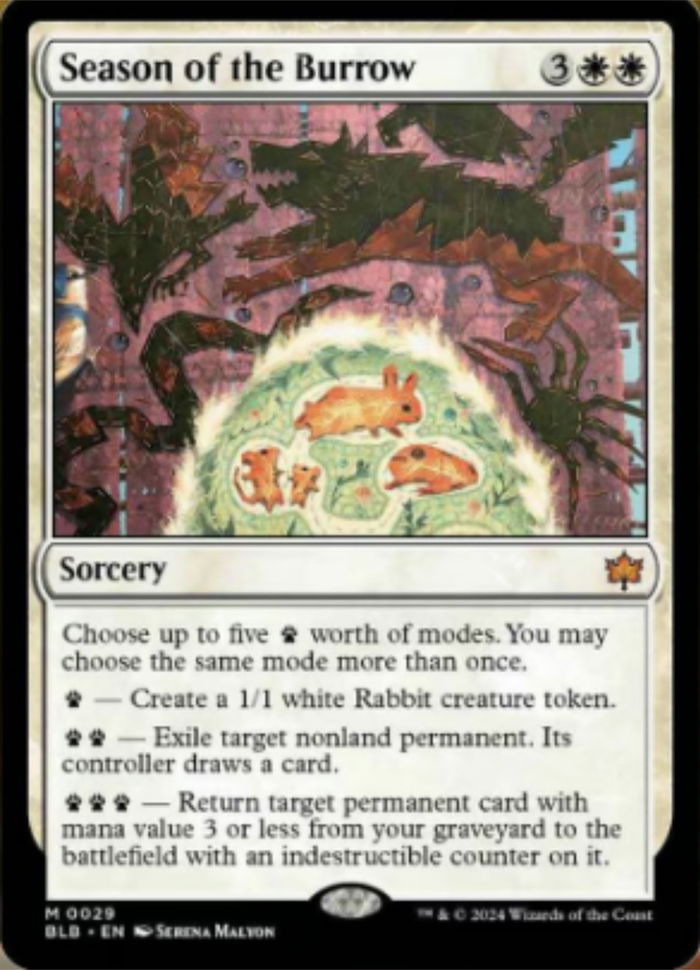
Season of the Burrow has a “go wide” function added to control elements with drawback (seriously, is it so difficult to have white removal that doesn't give the opponent a card? Does anyone remember Elspeth Conquers Death ?) and recursion.
Personally, I feel that he would be stronger if the second and third modules were swapped, even if we removed the Indestructible counter from this ability. But in its current conception, the card is still pretty decent for its mana cost:
Season of the Burrow is certainly one of the most flexible of the cycle, perhaps the best or second best among them, being able to fit both Midranges and more aggressive strategies that benefit from its abilities, even going through Control lists through its ability to deal two permanents at once and serve as a win condition.
Ad
However, its cost is high for non-rotating formats, and while it can appear as a one-of in Pioneer in decks like Azorius Control or even serve to resort to Greasefang, Okiba Boss or Amalia Benavides Aguirre (not counting the disgusting situation where it returns Wildgrowth Walker with an Indestructible counter and starts an infinite loop), the format's Metagame doesn't seem to favor this card so much today.
Season of Weaving
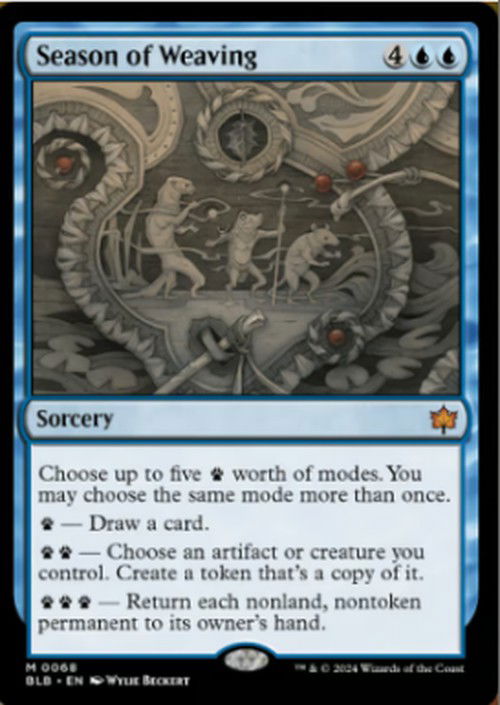
Season of Weaving screams “Control” and “things blue does” in basically every line of text. For six mana and as a spell, only one of its effects appears to be really worth it:
This module is an pseudo-extra turn on several occasions, and while it doesn't deal with Gleeful Demolition tokens, it probably gives enough time to get back into the game, but it's not the kind of card that a Control deck would be used instead of a sweeper, so the space it can have is in Ramp, if these exist in the next Standard, as it allows holding the match while helping to look for bombs in the deck, in addition to this archetype managing cast the card before the sixth turn.
This module is counterintuitive and should rarely be used in this way.
These modules look pretty decent, but they also sound a bit win more, meaning they require you to already be ahead in the game to be relevant. The flexibility of the other modules helps mitigate this issue, so having these options adds some value.
Opportunity offers four cards for six mana at Instant-Speed and has never seen much play, so drawing five cards with Season of Weaving isn't a big deal, but like the other modules, it should pay off in some cases.
Outside of Ramp, the blue Season doesn't seem to have a well-defined home in any format today, and should be limited to Standard unless a player discovers broken interactions with it in Pioneer.
Season of Loss
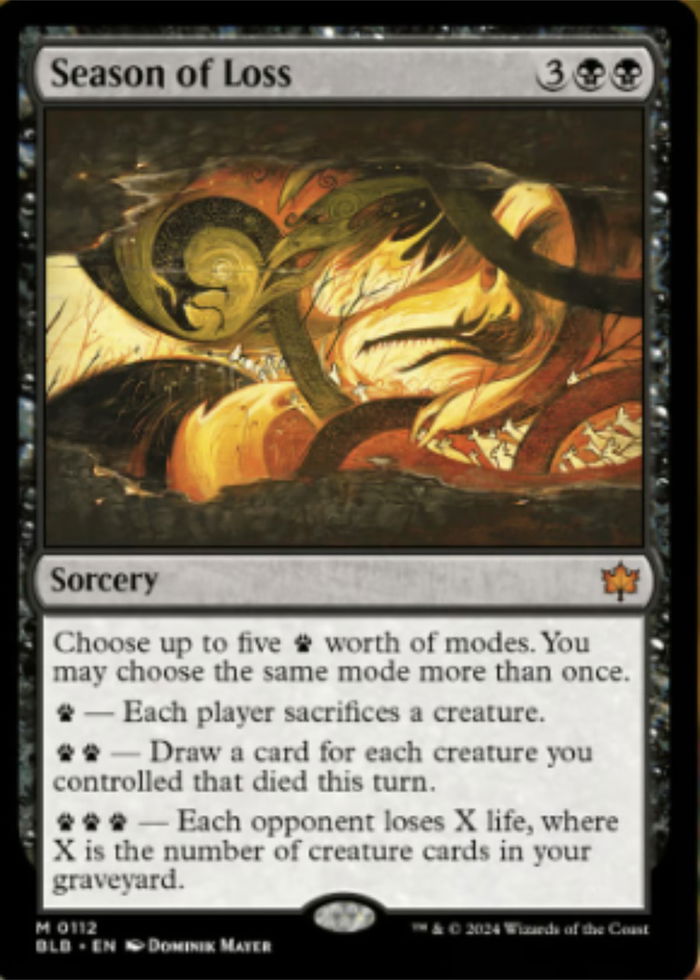
Season of Loss is, on first impression, the strongest of the cycle because it will often operate as a sweeper while offering more value with its other modules in attrition games:
Barter in Blood on steroids is decent, but decks that want Season of Loss probably don't want many creatures unless they have sacrifice interactions.
Ad
Perhaps this module would be useful in attrition games where we need to make many trades in combat, but it seems the least impressive of the available options.
It seems like another option for when we make trades in combat and/or when we are surprised by a bad block and removals. Generates a lot of value on its own if at least two creatures have died in the same turn.
Perhaps the best option on the card. Removing three threats from the game and drawing three cards for five mana is a good trade-off for attrition games, as long as the creatures we lose are less relevant than the opponent's.
Generally, this module will function as a five-mana sweeper, which is not ideal, but whose flexibility will probably favor its use over other black sweepers in Standard.
Its space in Pioneer does not seem guaranteed, but there may be some archetypes that are interested in one or two copies of the card, but the competition is much greater given that it is significantly worse against Aggro, but can help in dealing with Vein Ripper on Midrange mirrors.
Season of the Bold
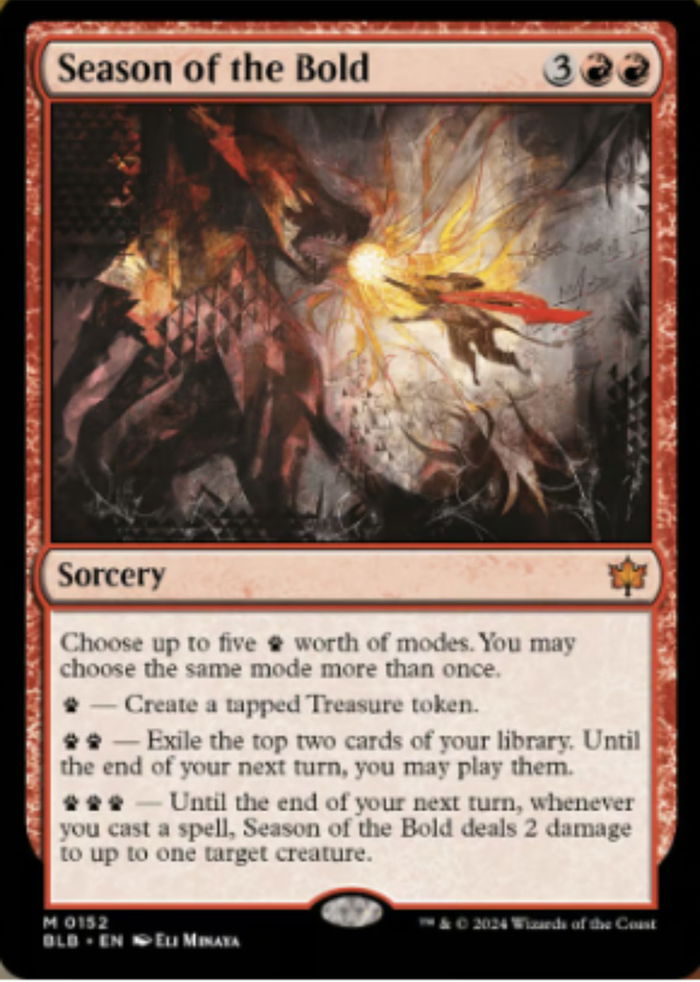
Season of the Bold is the worst card of the cycle. None of its effects compensate for its mana value, it is very conditional and the fact that its last ability only targets creatures means that it also doesn't work to do a “pseudo-Storm” the next turn.
Its best modules are exiling cards and creating Treasures, but none of them justify the cost of five mana, and this card is unlikely to have the potential to impact competitive formats.
Season of Gathering
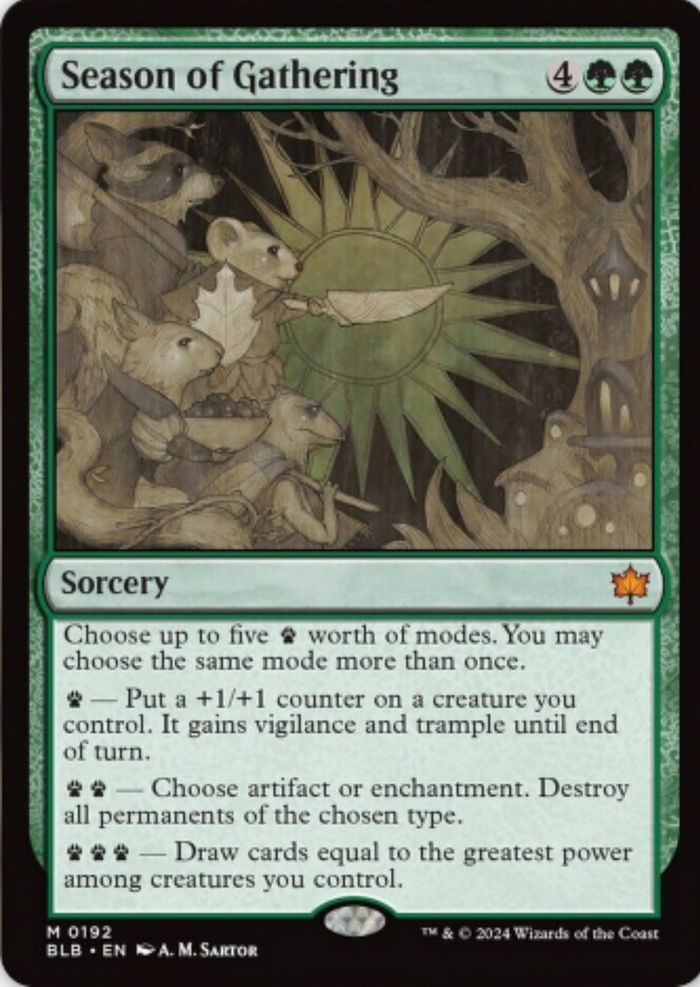
Season of Gathering is interesting, but doesn't do anything impressive for six mana.
Effects like this have the problem of requiring you to be too ahead to work, but the flexibility of choosing between artifacts or enchantments (and being able to choose both in another module) makes it a valid option.
Probably the most useful module when the card releases. The mix of evasion and card advantage should put this card on the same level as something like Rishkar’s Expertise, which never did much in Standard, but sees a lot of play in Commander.
Ad
Creeping Corrosion on steroids for two more mana is a good effect, and the two more mana is offset by the card's flexibility.
A gigantic pump for six mana, with evasion, isn't very impressive, but it can win games out of nowhere against unprepared opponents.
Season of Gathering seems too conditional to work because its best modules almost always depend on having a creature in play - and protecting it from removal can be a huge obstacle to this card's viability.
Finishing
That's all for today!
If you have any questions or suggestions, feel free to leave a comment!
Thanks for reading!








— Comentarios0
Se el primero en comentar